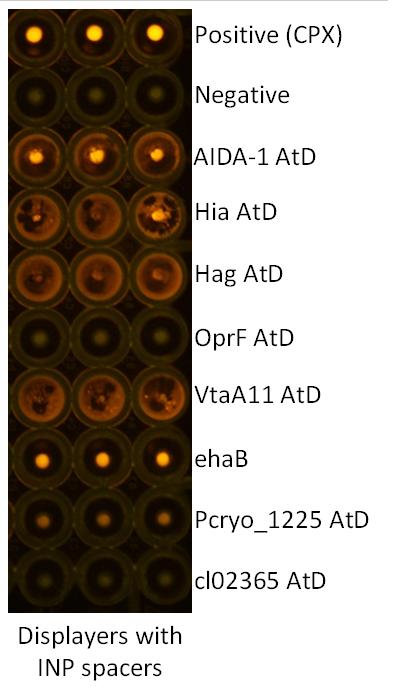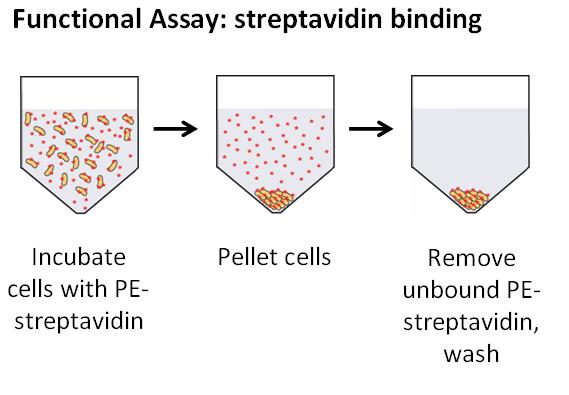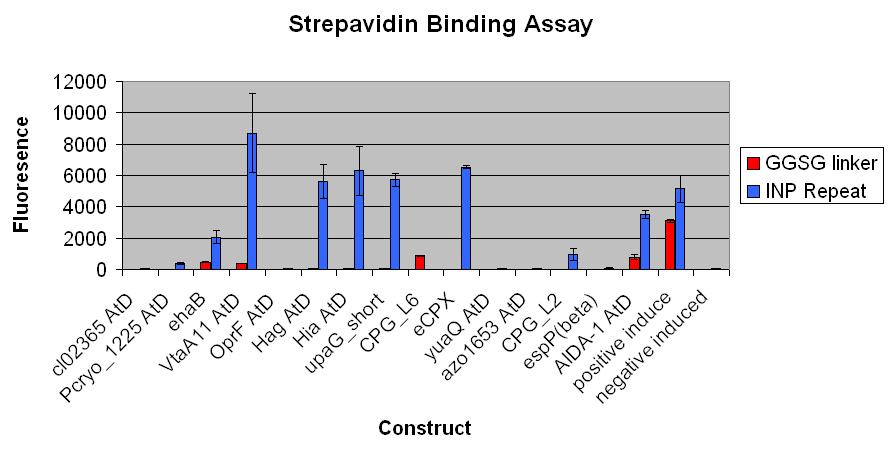Team:Berkeley Wetlab/Passenger: Streptavidin
From 2009.igem.org
Jennbrophy (Talk | contribs) (→Functional Assay: Fluorescent Plate Reader) |
|||
| (3 intermediate revisions not shown) | |||
| Line 1: | Line 1: | ||
{{newtemplateBerkeley}} | {{newtemplateBerkeley}} | ||
| + | __NOTOC__ | ||
==Strepavidin Binding Peptide== | ==Strepavidin Binding Peptide== | ||
With the display of numerous of on the surface of a cell, there is a need determine the viability of the proteins. One such method is to tag the displayed proteins. By displaying a strepavidin binding protein, we can effectively tag displayers as well as other proteins of interest. The strepavidin binding protein is a short peptide sequence (SAECHPQGPPCIEGRK) that binds onto strepavidin. Using a streptavidin, R-phycoerythrin conjugate (SAPE), we can fluorescently tag proteins and displayers for high through-put, automated analysis. | With the display of numerous of on the surface of a cell, there is a need determine the viability of the proteins. One such method is to tag the displayed proteins. By displaying a strepavidin binding protein, we can effectively tag displayers as well as other proteins of interest. The strepavidin binding protein is a short peptide sequence (SAECHPQGPPCIEGRK) that binds onto strepavidin. Using a streptavidin, R-phycoerythrin conjugate (SAPE), we can fluorescently tag proteins and displayers for high through-put, automated analysis. | ||
| Line 6: | Line 7: | ||
'''This assay tests for the presence of a functional strep binding peptide on the E. coli cell surface via its ability to bind to streptavidin, R-phycoerythrin conjugate (SAPE)'''<br> | '''This assay tests for the presence of a functional strep binding peptide on the E. coli cell surface via its ability to bind to streptavidin, R-phycoerythrin conjugate (SAPE)'''<br> | ||
| - | [[Image:IGem2009Berkeley_strep_cartoon.JPG]]<br> | + | [[Image:IGem2009Berkeley_strep_cartoon.JPG|center]]<br> |
'''Constructs:''' <br> | '''Constructs:''' <br> | ||
| Line 47: | Line 48: | ||
Jeffrey J. Rice and Patrick S. Daugherty. Directed evolution of a biterminal bacterial display scaffold enhances the display of diverse peptides. Protein Engineering, Design and Selection. July 2008; 21(7): 435–442. Available online at: http://www.ncbi.nlm.nih.gov/pmc/articles/PMC2427320/ | Jeffrey J. Rice and Patrick S. Daugherty. Directed evolution of a biterminal bacterial display scaffold enhances the display of diverse peptides. Protein Engineering, Design and Selection. July 2008; 21(7): 435–442. Available online at: http://www.ncbi.nlm.nih.gov/pmc/articles/PMC2427320/ | ||
| - | + | K. Terpe. Overview of tag protein fusions: from molecular and biochemical fundamentals to commercial systems. Applied Microbiology and Biotechnology. January 2003; 60(5): 523-533. Available online at: http://www.springerlink.com/content/euj72wc9a8l23dtu/ | |
| - | + | ||
| - | + | ||
| - | + | ||
| - | + | ||
Latest revision as of 18:02, 21 October 2009
Strepavidin Binding Peptide
With the display of numerous of on the surface of a cell, there is a need determine the viability of the proteins. One such method is to tag the displayed proteins. By displaying a strepavidin binding protein, we can effectively tag displayers as well as other proteins of interest. The strepavidin binding protein is a short peptide sequence (SAECHPQGPPCIEGRK) that binds onto strepavidin. Using a streptavidin, R-phycoerythrin conjugate (SAPE), we can fluorescently tag proteins and displayers for high through-put, automated analysis.
Functional Assay: Fluorescent Plate Reader
This assay tests for the presence of a functional strep binding peptide on the E. coli cell surface via its ability to bind to streptavidin, R-phycoerythrin conjugate (SAPE)
Constructs:
Strepavidin binding protein with GGSG linker (15)
Strepavidin binding protein with INP repeat linker (14)
1363 Negative Control (1) (Strepavidin binding protein targeted to periplasm)
9494 Positive Control (1) (Displayed circularly permuted OmpX)
All experiments are done in triplicate
cell growth and induction
1. Grow a cells in a liquid culture overnight to saturation.
2. Make a 1:10 dilution the following day of the saturated cultures and innoculate with arabinose (100 μg/mL final concentration) and incubate for 5-6 hours.
3. Before assaying, measure OD600.
incubate with SAPE and Assay
1. Add 100 uL of cells to a polystyrene (PS) V-bottomed 96-well plate. Centrifuge and pellet the cells.
2. Flick away LB media and resuspend pellets in 100 uL PBS with 5.0 ug/mL of Streptavidin-PE.
3. Seal well plate with a film and incubate at 37C without shaking for 30
minutes.
4. Pellet the cells, remove the seal, and flick away PBS/Streptavidin-PE, keeping the cell pellets.
5. Pellet cells again and flick away the PBS wash.
6. Resuspend the pellets in 100 uL PBS, then pellet the cells and flick away
the PBS wash.
7. Resuspend one last time in 100 uL PBS, taking care that the pellet has been completely resuspended.
8. Take an OD measurement after 3 washes, to ensure that we have not lost too much of the cells.
9. Take a Fluorescence measurement at Excitation wavelength of 488nm and emission wavelength 575 nm
Results
Data

UV image of strepavidin binding peptides
incubated with strepavidin and washed.
Fluorescence of strepavidin binding protein with GGSG linker and INP repeats. The INP repeats greatly improved display.
Conclusion
While at first it seems trivial to display a small peptide such as the strepavidin binding protein, from the results, it seems that this is not the case. Many of the displayed strepavidin binding proteins did not work. There seems to be a strong context effect between the linker sequence used and the function of the displayed protein. The use of a larger linkers such as an INP repeat seems to help the cell surface display.
References
Jeffrey J. Rice and Patrick S. Daugherty. Directed evolution of a biterminal bacterial display scaffold enhances the display of diverse peptides. Protein Engineering, Design and Selection. July 2008; 21(7): 435–442. Available online at: http://www.ncbi.nlm.nih.gov/pmc/articles/PMC2427320/
K. Terpe. Overview of tag protein fusions: from molecular and biochemical fundamentals to commercial systems. Applied Microbiology and Biotechnology. January 2003; 60(5): 523-533. Available online at: http://www.springerlink.com/content/euj72wc9a8l23dtu/
 "
"








